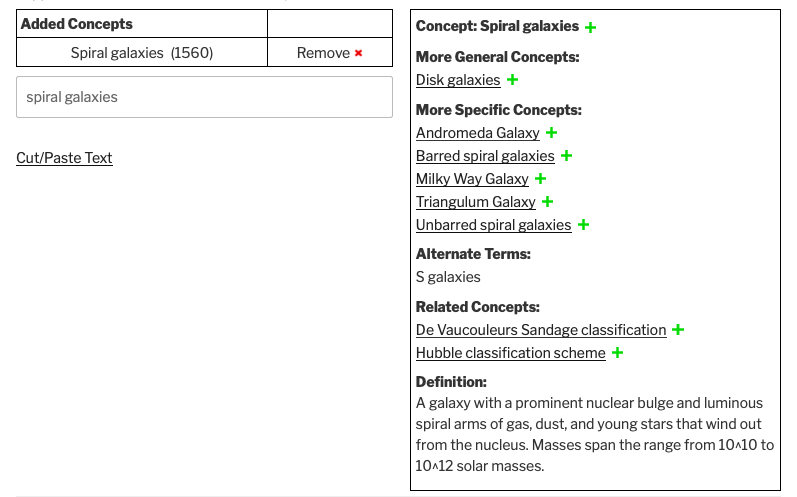This was originally posted on AAS Nova, written by Susanna Kohler , 12 February 2021.
Remember the Unified Astronomy Thesaurus? The UAT is an open, interoperable, and community-supported project that formalizes astronomical concepts and their inter-relationships into a high quality, freely available open resource. This resource can then be used to tag astronomical work — like articles, proposals, and datasets — with accurate, broadly adopted concepts.
The UAT has taken off in the year since we last reported on it! AAS journals have all moved entirely to using the more flexible and dynamic UAT in place the old, static keyword system. In addition, adoption is increasing across the broader astronomical community: the UAT has been implemented by the AAS journals, the Publications of the Astronomical Society of the Pacific, the International Virtual Observatory Alliance, the proposal system for the Hubble Space Telescope, and WikiData.
This week brings two news items from the UAT:
- An opportunity to join the UAT Steering Committee
- An update on the newest release of the UAT.
A Quick Refresher
Why is the UAT so cool? Simply put, organizing information is hard — but the UAT has provided a much-needed modern update for astronomy. Old systems of static keywords fail to capture the multidimensional nature of how concepts can relate to each other. When using the UAT to select keywords for their work, now, authors have access to a much broader range of suggestions that allow them to more accurately reflect what their work is about.
An example: suppose I’m writing an article on spiral galaxies. If I enter this concept into the UAT, the Thesaurus knows that spiral galaxies fall under the parent concept of disk galaxies, and it also knows that Andromeda is a specific example of a spiral galaxy. What’s more, it’s aware that spiral galaxies are also referred to as S galaxies, and that the topic might come up in the related concept of the Hubble galaxy classification scheme.

The relationships charted within the UAT make it much easier for me to select the concepts that best describe the article I’m writing, the UAT’s living and adaptable nature allows it to keep up with changing times, and universal adoption of the UAT will greatly simplify the organization of information across platforms.
Become a UAT Steering Committee Member!
Are you convinced that this is a cool concept? Want to help shape the future development of the UAT? The UAT Steering Committee is seeking a new member.
The Steering Committee (SC) sets the general parameters for the overall direction of the UAT and is composed of representatives from groups with a direct stake in the development and success of the Thesaurus. Members of the SC also serve as representatives of the UAT, promoting it to global astronomy and astrophysics, library, and publishing communities; developing test cases; and increasing its overall use.
The UAT currently welcomes expressions of interest in the open SC position from astronomers, researchers, librarians, and others. The commitment is a two-year term and includes monthly SC meetings. You can contact the chair of the UAT SC, Barbara Kern, with “UAT Steering Committee” in the subject line to express your interest or to ask any questions. [Note: This year’s call for interest closed February 2021 –Katie Frey]
What’s New in the Latest UAT Update
In December 2020, Version 4.0.0 of the UAT was released to the worldwide astronomical community.
UAT v.4.0.0 added nearly 50 new concepts in the areas of planetary science and exoplanets and also added definitions — largely sourced from the Etymological Dictionary of Astronomy and Astrophysics — for about 40% of all existing concepts for the first time. For examples of concept definitions, see the image above for the spiral galaxies concept or view the file for baryonic dark matter. More accompanying definitions are expected in future releases.
A number of technical updates were also implemented in v.4.0.0. Deprecated concepts can now be found in the UAT GitHub repository, and there are multiple json files to choose from if implementing the Unified Astronomy Thesaurus in your local systems. For comprehensive v.4.0.0 release notes, visit https://astrothesaurus.org/blog/.
Where to Learn More
- UAT website
- AAS Nova introduction to UAT
- Powered by the Unified Astronomy Thesaurus videos
This Youtube playlist contains brief videos that include tutorials for UAT use, discussions of its features, an introduction to how authors can influence the UAT, a look at how the UAT has been used in publications so far, and more. - UAT Sorting Tool
Want to help the UAT get its concepts right? This fun visualization tool makes contributing a breeze.


